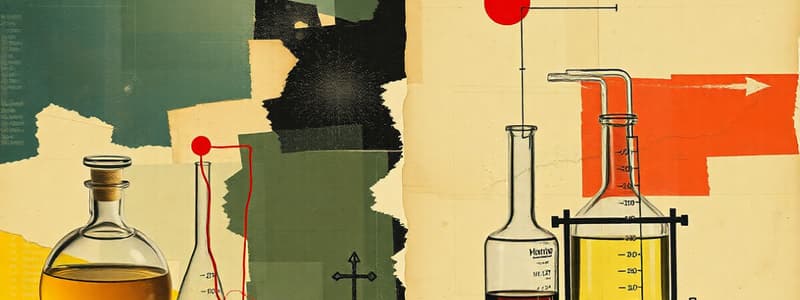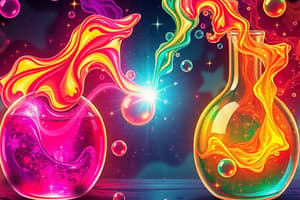Podcast
Questions and Answers
What two products are formed during a neutralization reaction?
What two products are formed during a neutralization reaction?
Water and salt.
How do antacids work to relieve heartburn, according to the text?
How do antacids work to relieve heartburn, according to the text?
Antacids neutralize excess stomach acid.
During neutralization, what ions from the acid react with ions from the base?
During neutralization, what ions from the acid react with ions from the base?
H+ ions react with OH- ions.
What pH is considered neutral when mixing equal amounts of acid and base?
What pH is considered neutral when mixing equal amounts of acid and base?
What happens to a solution if too much base is added during a neutralization reaction?
What happens to a solution if too much base is added during a neutralization reaction?
What determines the name of the salt formed in a neutralization reaction?
What determines the name of the salt formed in a neutralization reaction?
If hydrochloric acid (HCl) is used in a reaction, what type of salt is formed?
If hydrochloric acid (HCl) is used in a reaction, what type of salt is formed?
What is the general function of buffer solutions?
What is the general function of buffer solutions?
Besides milk and saliva, what is another solution mentioned in the text that can resist pH changes?
Besides milk and saliva, what is another solution mentioned in the text that can resist pH changes?
How does the addition of lime (calcium carbonate) to acidic soil help plants?
How does the addition of lime (calcium carbonate) to acidic soil help plants?
Flashcards
What is Neutralization?
What is Neutralization?
A chemical reaction between an acid and a base that produces water and salt.
Examples of Neutralization
Examples of Neutralization
Antacids neutralize stomach acid, vinegar neutralizes jellyfish stings, and baking soda neutralizes insect bites.
How Neutralization Works
How Neutralization Works
H+ ions from the acid react with OH- ions from the base to form water and a salt.
pH and Neutralization
pH and Neutralization
Signup and view all the flashcards
Formation of Salts
Formation of Salts
Signup and view all the flashcards
Buffer Solutions
Buffer Solutions
Signup and view all the flashcards
Acid-Salt examples
Acid-Salt examples
Signup and view all the flashcards
Study Notes
- H+ + H2O → H3O+
- HCL = Chloride
- HNO3 = Nitrate
- H2SO4 = Sulfate
- H3Po4 = Phosphate
What is Neutralization?
- Neutralization is a chemical reaction between an acid and a base.
- The reaction produces water and salt.
- Example: Hydrochloric acid (HCL) + Sodium hydroxide (NaOH) → water (H2O) + Sodium chloride (NaCl)
Everyday examples of Neutralization
- Treating heartburn: Antacids (like magnesium hydroxide) neutralize excess stomach acid.
- Sting and bites: Vinegar can neutralize jellyfish stings (alkaline), while baking soda can neutralize insect bites (acidic).
- Soil treatment: Lime (calcium carbonate) is added to acidic soil to make it more neutral for plants.
How Neutralization Works
- H+ ions from the acid react with OH- ions from the base, forming water.
- The leftover ions form a salt.
- If equal amounts of acid and base are mixed, the solution becomes neutral (pH 7).
PH and Neutralization
- Acids have a pH lower than 7, bases have a higher pH than 7.
- An indicator (like litmus paper or phenolphthalein) can show when a solution reaches neutrality.
- If too much base is added, the solution becomes alkaline and vice versa.
Formation of salts
- The name of a salt comes from the acid and base used in the reaction.
- Hydrochloric acid (HCL) → Chloride salts (NaCl, CaCl)
- Sulfuric acid (H2SO4) → Sulfate salts (MgSO4, Na2SO4)
- Nitric acid (HNO3) → Nitrate salts (NaNO3, KNO3)
Buffer solutions
- Buffer solutions resist pH changes
- Some solutions like milk, blood, and saliva resist pH changes.
- Buffers help maintain stable pH in biological systems.
Studying That Suits You
Use AI to generate personalized quizzes and flashcards to suit your learning preferences.




